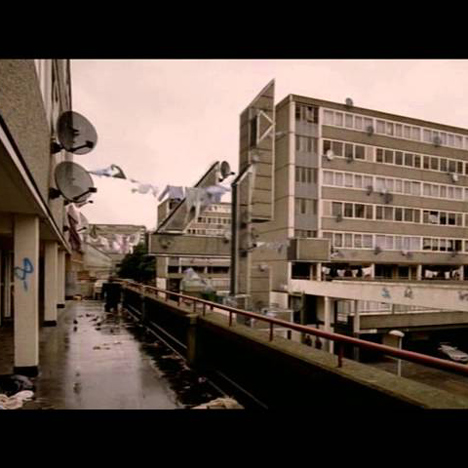News: residents of a Brutalist housing development in London have persuaded Channel 4 to screen a home-made version of the broadcaster's ident after a lengthy campaign against its "inaccurate" portrayal of life on the estate.
The offending ident is used by Channel 4 as programs are introduced and depicts a desolate concrete urban environment strewn with rubbish, washing lines and satellite dishes.
"The ident includes embellishments such as bin bags, discarded shopping trolleys and graffiti — all added in post production," explained community worker Charlotte Benstead. "The Aylesbury has had a long and undeserved reputation. Channel 4 is just emphasising the negatives."
"It's a bad thing," Benstead added. "It points a finger at anyone living on a 1970's estate and makes a statement about how people there live."
Attention has focused on the ten-year-old ident following a recent campaign by tenants to force it off the air. As part of the battle, Aylesbury's residents teamed up with filmmaker Nick Street to create a new version of Channel 4's original.
"Residents are fed up with seeing their homes on Channel 4 shown to be dirty and messy," said Benstead. "We wanted to remake it showing how the estate really is."
Following continued pressure from the community and widespread media coverage, Channel 4 has offered to showcase the community's version "based on liking the creative, not on a belief that the original is wrong and needs to be replaced."
Channel 4 refutes all claims that they have created negative perceptions of the community and vows to continue broadcasting the ident.
In an email to campaign organisers, Channel 4's Charlie Palmer stated that the ident is "a conceptual creative which doesn't claim to represent a specific place and is never identified as the Aylesbury estate."
Channel 4 will broadcast the ident created by Nick Street on Friday 14 March at 9pm after it's introduced by an announcer. Residents have been promised a preview of the script but are yet to see it.
The Aylesbury estate was designed in 1963 to house 10,000 people in response to the chronic housing shortage of the day by Austrian architect Hans Peter Trenton. The project was the largest, most ambitious postwar public housing scheme in Europe at the time.
In 1971 the first tenants moved in and the estate's architecture quickly came under attack. As architect and city planner Oscar Newman toured the estate for BBC's Horizon program in 1974, his conclusion was that modern architecture actually encouraged people to commit crime.
Victim of cost-cutting and poor construction, the Aylesbury became emblematic of the shortcomings of postwar public housing and a byword for crime and poverty. Incoming prime minister Tony Blair used the Aylesbury estate in 1997 to deliver a message that there would be "no more forgotten people" in Britain. Despite the setbacks, in 2001 the majority of residents voted against its demolition.

